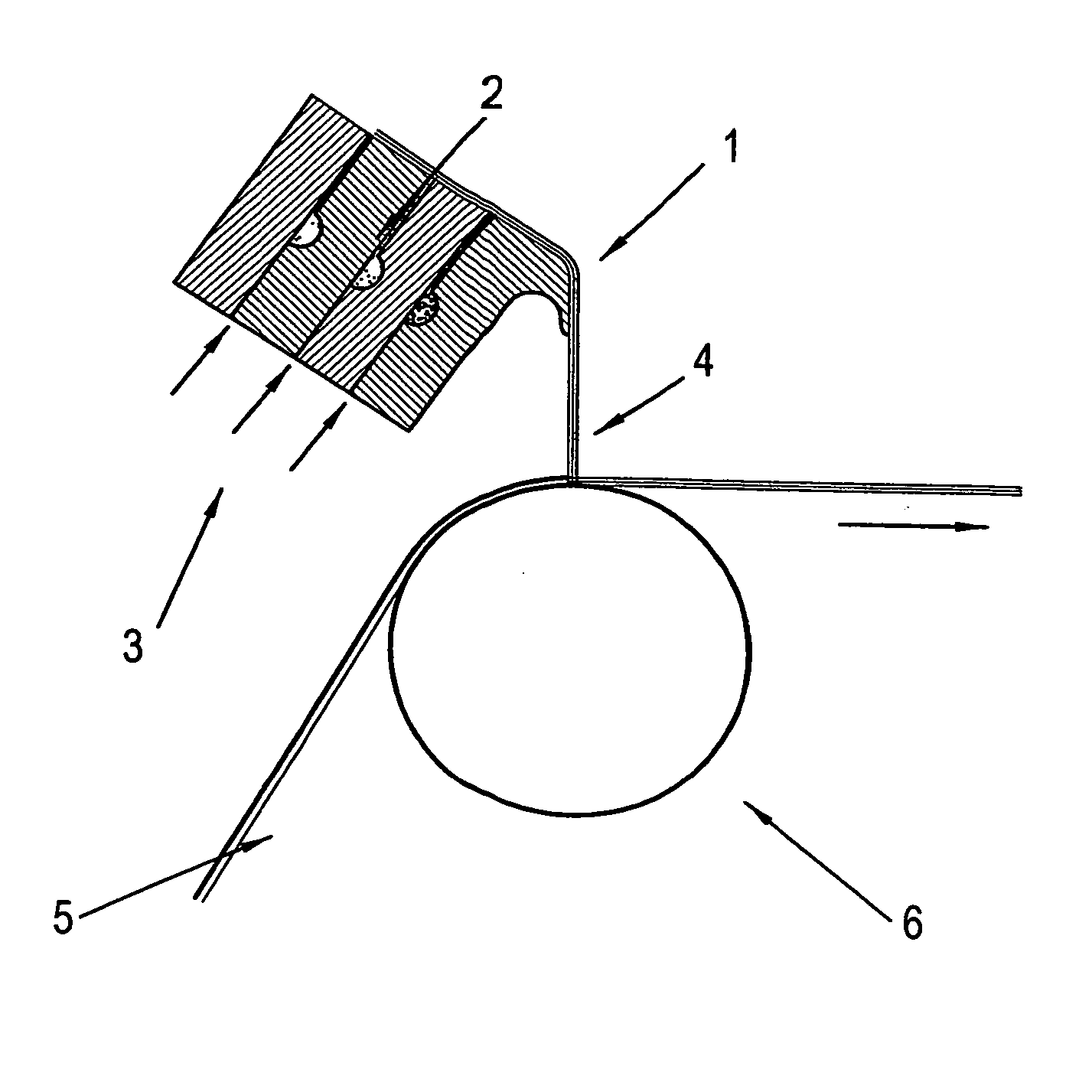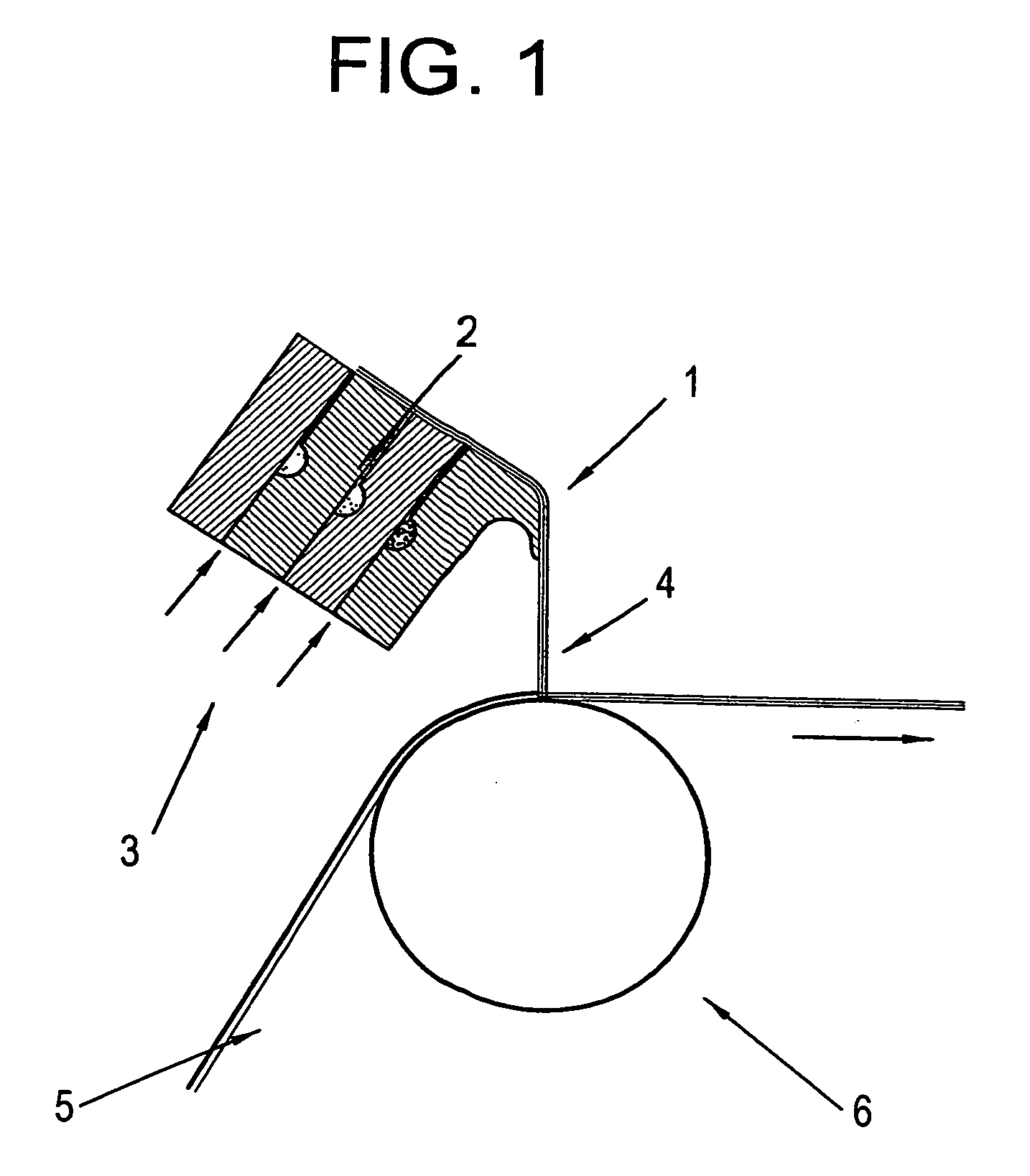Process for making coated paper or paperboard
- Summary
- Abstract
- Description
- Claims
- Application Information
AI Technical Summary
Benefits of technology
Problems solved by technology
Method used
Image
Examples
example 1
[0104] The above ingredients are mixed in the amounts given in Table 1 to demonstrate the use of the high aspect ratio clay.
TABLE 1Slot 1Slot 2Carbonate (A)100Clay (B)100Latex1313PVOH13.5Surfactant0.40.2Whitener1pH8.58.6Solids (%)60.155.7Density (g / cm3)1.511.43Brookfield Viscosity [mPa · s]120755Viscosity at 3,000 s−1 [mPa · s]29.9114Viscosity at 30,000 s−1 [mPa · s]13.5150Viscosity at 500,000 s−1 [mPa · s]13.657.9Shear-Thickening Index0.451.32
[0105] The viscosity at 500,000 s−1 for the coating in Slot 2 exceeds the range observed to be problematic for running on blade coaters (greater than 50 mPa.s) and the shear thickening index is greater than 1.2.
[0106] The trial speeds and coatweights for each layer for Example 1 are given in Table 2. The basepaper is a wood-containing paper with a surface roughness of 4.3 microns.
TABLE 2SpeedSlot 1Slot 2[m / min]coatweightg / m2(dry)coatweightg / m2(dry)100026100028120028150028
[0107] A pigmented layer (slot 1) is placed next to the paper. A sec...
example 2
[0108] The above ingredients are mixed in the amounts given in Table 3 to demonstrate the use of the calcined clay.
TABLE 3Slot 1Slot 2Carbonate (A)100Clay100Latex (A)1313PVOH13.5Surfactant0.40.2Whitener1pH8.58.6Solids (%)60.147.9Density (g / m2)1.511.36Brookfield Viscosity [mPa · s]120470Viscosity at 3,000 s−1 [mPa · s]29.930.7Viscosity at 30,000 s−1 [mPa · s]13.547.6Viscosity at 500,000 s−1 [mPa · s]13.6105.2Shear-Thickening Index0.451.55
[0109] The viscosity at 500,000 s−1 for the coating in Slot 2 exceeds the range observed to be very problematic for running on blade coaters (greater than 100 mPa.s) and the shear thickening index is greater than 1.5.
[0110] Trial speed and coatweights for each layer of Example 2 are given in Table 4. The basepaper is a wood-containing paper with a surface roughness of 4.3 microns.
TABLE 4SpeedSlot 1 coatweightSlot 2 coatweight[m / min]g / m2(dry)g / m2(dry)100026100028120026120028
[0111] A pigmented layer (slot 1) is placed next to the paper. A second l...
example 3
[0112] The method of Example 1 is repeated using a thickener in place of some of the polyvinyl alcohol (PVOH) in the top layer (Slot 2). The thickener employed in the comparative experiments is chosen for its compatibility for high-speed blade coating as well as for its ability to provide crater-free curtain coating at high coating speeds. In addition, the amount of PVOH in the bottom layer (Slot 1) is increased to 2 parts and the whitener is removed from the top layer (Slot 2). The coating ingredients are mixed in the amounts given in Table 5.
TABLE 5Slot 1Slot 2Carbonate (A)100Clay (B)100Latex1313PVOH21.0Thickener (A)0.2Surfactant0.40.2pH8.58.6Solids (%)60.355.8Density (g / cm3)1.511.43ABO Water Retention (g / m2) NM*76Brookfield Viscosity [mPa · s]350740Viscosity at 3,000 s−1 [mPa · s]NM153Viscosity at 30,000 s−1 [mPa · s]NM214Viscosity at 500,000 s−1 [mPa · s]NM96Shear-Thickening IndexNM1.39
(*NM = Not Measured)
[0113] The viscosity at 500,000 s−1 for the coating in Slot 2 exceeds t...
PUM
| Property | Measurement | Unit |
|---|---|---|
| Temperature | aaaaa | aaaaa |
| Diameter | aaaaa | aaaaa |
| Viscosity | aaaaa | aaaaa |
Abstract
Description
Claims
Application Information
 Login to View More
Login to View More - R&D
- Intellectual Property
- Life Sciences
- Materials
- Tech Scout
- Unparalleled Data Quality
- Higher Quality Content
- 60% Fewer Hallucinations
Browse by: Latest US Patents, China's latest patents, Technical Efficacy Thesaurus, Application Domain, Technology Topic, Popular Technical Reports.
© 2025 PatSnap. All rights reserved.Legal|Privacy policy|Modern Slavery Act Transparency Statement|Sitemap|About US| Contact US: help@patsnap.com


